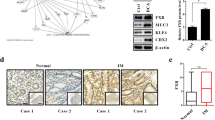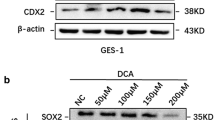Abstract
Objective
To study the effects of Weipixiao (胃痞消, WPX) on Wnt pathway-associated proteins in gastric mucosal epithelial cells from rats with gastric precancerous lesions (GPL).
Methods
Sprague Dawley rats were randomly divided into control, model, vitacoenzyme (0.2 g·kg−1·day−1), WPX high-dose (H-WPX, 15 g·kg−1·day−1), WPX medium-dose (M-WPX, 7.5 g·kg−1·day−1) and WPX low-dose (L-WPX, 3.75 g·kg−1·day−1) groups. After successfully establishing the GPL model, the rats were consecutively administered WPX or vitacoenzyme by gastrogavage for 10 weeks. Differential expression of Leucine-rich repeat-containing G-proteincoupled receptor 5 (Lgr5), matrix metalloproteinase-7 (MMP-7), Wnt1, Wnt3a, and β-catenin in gastric mucosal epithelial cells in all groups were immunohistochemically detected, and the images were taken and analyzed semiquantitatively by image pro plus 6.0 software.
Results
Gastric epithelium in the model group showed significantly higher expression levels of Lgr5, MMP-7, Wnt1, Wnt3a and β-catenin than those of the control group(P<0.01). Interestingly, we also observed Lgr5+ cells, which generally located at the base of the gastric glandular unit, migrated to the luminal side of gastric epithelium with GPL. The expression levels of Lgr5, MMP-7, Wnt1, and β-catenin were all down-regulated in the L-WPX group as compared with those of both model and vitacoenzyme groups (P<0.05). A similar, but nonsignificant down-regulation in expression level of Wnt3a was noted in all WPX groups (P>0.05).
Conclusion
Our findings suggested that the therapeutic mechanisms of WPX in treating GPL might be related with its inhibitory effects on the expressions of Lgr5, MMP-7, Wnt1, β-catenin and the aberrant activation of Wnt/β-catenin pathway.
Similar content being viewed by others
References
Jemal A, Bray F, Center MM, Ferlay J, Ward E, Forman D. Global cancer statistics. CA Cancer J Clin 2011;61:69–90.
Ferlay J, Shin HR, Bray F, Forman D, Mathers C, Parkin DM. Estimates of worldwide burden of cancer in 2008: GLOBOCAN 2008. Int J Cancer 2010;127:2893–2917.
Zhang H, Xue Y. Wnt pathway is involved in advanced gastric carcinoma. Hepato-gastroenterology 2008;55:1126–1130.
Huang J, Xiao D, Li G, Ma J, Chen P, Yuan W. EphA2 promotes epithelial-mesenchymal transition through the Wnt/beta-catenin pathway in gastric cancer cells. Oncogene 2014;33:2737–2747.
Carmon KS, Lin Q, Gong X, Thomas A, Liu Q. LGR5 interacts and cointernalizes with Wnt receptors to modulate Wnt/betacatenin signaling. Mol Cell Biol 2012;32:2054–2064.
Barker N, Huch M, Kujala P, van de Wetering M, Snippert HJ, van Es JH. Lgr5(+ve) stem cells drive self-renewal in the stomach and build long-lived gastric units in vitro. Cell Stem Cell 2010;6:25–36.
Wu C, Xie Y, Gao F, Wang Y, Guo Y, Tian H. Lgr5 expression as stem cell marker in human gastric gland and its relatedness with other putative cancer stem cell markers. Gene 2013;525:18–25.
McClanahan T, Koseoglu S, Smith K, Grein J, Gustafson E, Black S. Identification of overexpression of orphan G protein-coupled receptor GPR49 in human colon and ovarian primary tumors. Cancer Biol Ther 2006;5:419–426.
Yamamoto Y, Sakamoto M, Fujii G, Tsuiji H, Kenetaka K, Asaka M. Overexpression of orphan G-protein-coupled receptor, Gpr49, in human hepatocellular carcinomas with beta-catenin mutations. Hepatology 2003;37:528–533.
Nakata S, Campos B, Bageritz J, Bermejo JL, Becker N, Engel F. LGR5 is a marker of poor prognosis in glioblastoma and is required for survival of brain cancer stem-like cells. Brain Pathol 2013;23:60–72.
von Rahden BH, Kircher S, Lazariotou M, Reiber C, Stuermer L, Otto C. LgR5 expression and cancer stem cell hypothesis: clue to define the true origin of esophageal adenocarcinomas with and without Barrett's esophagus? J Exp Clin Cancer Res CR 2011;30:23.
Ryuge S, Sato Y, Jiang SX, Wang G, Kobayashi M, Nagashio R. The clinicopathological signifi cance of Lgr5 expression in lung adenocarcinoma. Lung Cancer 2013;82:143–148.
Yamanoi K, Fukuma M, Uchida H, Kushima R, Yamazaki K, Katai H. Overexpression of leucine-rich repeat-containing G protein-coupled receptor 5 in gastric cancer. Pathol Int 2013;63:13–19.
Jang BG, Lee BL, Kim WH. Distribution of LGR5+ cells and associated implications during the early stage of gastric tumorigenesis. PloS One 2013;8:e82390.
Imai K, Yokohama Y, Nakanishi I, Ohuchi E, Fujii Y, Nakai N, Okada Y. Matrix metalloproteinase 7 (matrilysin) from human rectal carcinoma cells. Activation of the precursor, interaction with other matrix metalloproteinases and enzymic properties. J Biol Chem 1995;270:6691–6697.
Yamashita K, Mori M, Shiraishi T, Shibuta K, Sugimachi K. Clinical signifi cance of matrix metalloproteinase-7 expression in esophageal carcinoma. Clin Cancer Res 2000;6:1169–1174.
Koskensalo S, Louhimo J, Nordling S, Hagström J, Haglund C. MMP-7 as a prognostic marker in colorectal cancer. Tumour Biol 2011;32:259–264.
Kitoh T, Yanai H, Saitoh Y, Nakamura Y, Matsubara Y, Kitoh H. Increased expression of matrix metalloproteinase-7 in invasive early gastric cancer. J Gastroenterol 2004;39:434–440.
Sentani K, Matsuda M, Oue N, Uraoka N, Naito Y, Sakamoto N. Clinicopathological significance of MMP-7, laminin gamma2 and EGFR expression at the invasive front of gastric carcinoma. Gastric Cancer 2014;17:412–422.
Heslin MJ, Yan J, Johnson MR, Weiss H, Diasio RB, Urist MM. Role of matrix metalloproteinases in colorectal carcinogenesis. Ann Surg 2001;233:786–792.
Rath T, Roderfeld M, Graf J, Wagner S, Vehr AK, Dietrich C. Enhanced expression of MMP-7 and MMP-13 in inflammatory bowel disease: a precancerous potential?. Infl amm Bowel Dis 2006;12:1025–1035.
Brabletz T, Jung A, Dag S, Hlubek F, Kirchner T. Beta-catenin regulates the expression of the matrix metalloproteinase-7 in human colorectal cancer. Am J Pathol 1999;155:1033–1038.
He W, Tan RJ, Li Y, Wang D, Nie J, Hou FF. Matrix metalloproteinase-7 as a surrogate marker predicts renal Wnt/beta-catenin activity in CKD. J Am Soc Nephrol 2012;23:294–304.
Polakis P. Wnt signaling and cancer. Genes Dev 2000;14:1837–1851.
Logan CY, Nusse R. The Wnt signaling pathway in development and disease. Annu Rev Cell Dev Biol 2004;20:781–810.
Katoh M. Expression and regulation of WNT1 in human cancer: up-regulation of Wnt1 by beta-estradiol in MCF-7 cells. Int J Oncol 2003;22:209–212.
Guan WH, Yang K, Zhao WJ, Liu XS, Wang XJ. Significance of expression of Wnt3 and Wnt3a in gastric carcinoma. World Chin J Digestol (Chin) 2013;21:624–628.
Willert K, Nusse R. Beta-catenin: a key mediator of Wnt signaling. Curr Opin Genet Dev 1998;8:95–102.
Retterspitz MF, Monig SP, Schreckenberg S, Schneider PM, Hölscher AH, Dienes HP. Expression of beta-catenin, MUC1 and c-met in diffuse-type gastric carcinomas: correlations with tumour progression and prognosis. Anticancer Res 2010;30:4635–4641.
Seckin Y, Arici S, Harputluoglu M, Yonem O, Yilmaz A, Ozer H. Expression of claudin-4 and beta-catenin in gastric premalignant lesions. Acta Gastroenterol Belg 2009;72:407–412.
Guo YL, Rao J, Pan HF, Fang J. Effect of the treatment of Jianpi Huayu Jiedu for patients with chronic atrophic gastritis and its influence on cyclin E protein expression. Chin J Exp Tradit Med Form (Chin) 2013;19:292–295.
Pan HF, Ren JL, Zhao ZM, Liu J. Effect of Weipixiao on cell generation cycle distribution and apoptosis-related gene expression in gastric mucosal epithelial cells of gastric precancerous lesion rats with Spleen-deficiency chronic atrophic gastritis. J Guangzhou Univ Tradit Chin Med (Chin) 2010;27:488–491.
Zhao X, Pan HF, Ju XY, Fan NB, Yu SY, Luo YJ. Effects of Weipixiao on apoptosis and regulating caspase-3 in gastric mucous epithelial cells in chronic atrophic gastritis rats with Spleen defi ciency. Chin J Basic Med Tradit Chin Med (Chin) 2007;13:42–43.
Liu J, Pan HF, Zhao ZM, Xiao Y. Effect of weipixiao on peripheral blood T cell subsets in chronic atrophic gastritis gastric precancerous lesions rats with spleen defi ciency. Tradit Chin Drug Res Clin Pharmacol (Chin) 2010;21:116–118.
Chen XY, Zou SJ, Fan YL, Zhang YP. Pathological study of gastric mucosa in chronic atrophic gastritis models combining syndrome with disease in rats. Shanghai Laborat Animal Sci (Chin) 2002;22: 35–38.
Pan HF, Zhao ZM, Ren JL, Shi YF. Effect of Weipixiao acting on gastric epithelial intestinal metaplasia in chronic atrophic gastritis rats. Tradit Chin Drug Res Clin Pharmacol (Chin) 2012;23:55–57.
Correa P. A human model of gastric carcinogenesis. Cancer Res 1988;48:3554–3560.
de Vries AC, van Grieken NC, Looman CW, Casparie MK, de Vries E, Meijer GA. Gastric cancer risk in patients with premalignant gastric lesions: a nationwide cohort study in the Netherlands. Gastroenterology 2008;134:945–952.
Yee YK, Wong KW, Hui CK, Chan CK, Chan AO, Lam SK. Prevalence and time trend of intestinal metaplasia in Hong Kong. J Gastroenterol Hepatol 2009;24:896–899.
Silva S, Filipe MI, Pinho A. Variants of intestinal metaplasia in the evolution of chronic atrophic gastritis and gastric ulcer. A follow up study. Gut 1990;31:1097–1104.
Yamada H, Ikegami M, Shimoda T, Takagi N, Maruyama M. Long-term follow-up study of gastric adenoma/dysplasia. Endoscopy 2004;36:390–396.
Nelson AR, Fingleton B, Rothenberg ML, Matrisian LM. Matrix metalloproteinases: biologic activity and clinical implications. J Clin Oncol 2000;18:1135–1149.
Author information
Authors and Affiliations
Corresponding author
Additional information
Supported by the National Natural Science Foundation of China (No. 81273739)
Rights and permissions
About this article
Cite this article
Zeng, Jh., Pan, Hf., Liu, Yz. et al. Effects of Weipixiao (胃痞消) on Wnt pathway-associated proteins in gastric mucosal epithelial cells from rats with gastric precancerous lesions. Chin. J. Integr. Med. 22, 267–275 (2016). https://doi.org/10.1007/s11655-015-2131-4
Received:
Published:
Issue Date:
DOI: https://doi.org/10.1007/s11655-015-2131-4




